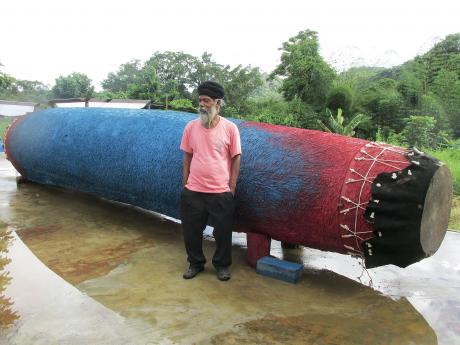Laura Facey-Cooper makes it big again
This time around it is a drum. About 20 feet long, it has to be the longest in Jamaica, and perhaps in all of the Caribbean. And it is not just a gigantic showpiece, it is functional as was demonstrated on Sunday, November 6, after it was unveiled to patrons at Farm to Table, held at Orange Hall Estates in St Ann.
The event, a potpourri of food, art and welfare, is the brainchild of sculptor Laura Facey-Cooper. This year, the proceeds go towards the development of an arts programme at Boys Town Infant and Primary School.
The big, two-headed gong, too, is Facey-Cooper's idea, and Arts and Education was present to hear the first public beats.
The cotton tree from which it was sculpted was blown down by Hurricane Sandy in 2012, and "I just felt inspired to make a double-sided drum," Facey-Cooper said. She wanted to reach out to the African and white ancestors who lived and worked on the Orange Hall Estates. It's all about healing and reconciliation - Africans at one end and Europeans at the other - having a conversation through drumbeats.
The process of making the drum started with the removal of the branches and other appendages. After it was made hollow at a river by men such as Jeffrey Hudson, Delroy Hudson, Jermaine Harrison, Omar Davidson, and Horace Rhoden, over a three-to-four-month period, it was dragged "back way" up a hill by a "contraption with wheels" made from an old truck chassis.
The outside, painted in red and indigo, is replete with grooves created by small chainsaws, while the openings are covered with cattle hide. Facey-Cooper said artesan and drummer, Fosuwa Andoh, guided her on how to dry the hide, and on the whole process of affixing it to the drum.
GREAT APPRECIATION
On Sunday, while Delroy Hudson beat the cotton tree drum, Andoh accompanied him on her Gimbay, to great appreciation from patrons. In response to questions of how she felt about the evolution of the drum from idea to reality, Facey said, "I'm happy I've come this far. I want to see it in full action." And as to where it will end up, Facey-Cooper does not know right now.
It is to be noted that the silk cotton tree from which the drum was crafted was a significant element in the rituals and narratives of enslaved west Africans in Jamaica, and so was the drum. No doubt, the sounds coming from it will convey powerful ancestral messages.



